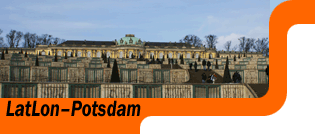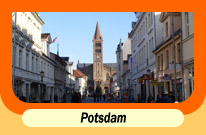The Middle Ages and the Rise of the Hohenzollern
Potsdam’s first written mention (by the name of Poztupimi – “below the oaks”) dates from July 3, 993. It is related to a donation of land, made by Holy Roman Emperor Otto III to his aunt Matilda of Quedlinburg, which proved to be almost worthless. Growing resistance from the Slav population drove the Germans out of the territories east of river Elbe, conquered under the King Henry I (913-936) and Holy Roman Emperor Otto the Great (936-973).
The German eastward expansion was taken up again, when Albrecht (the Bear / 1136-70) from the House of Ascania succeed to secure the March of Brandenburg. At that time, the city of Brandenburg was seat of the bishop and the margrave. The Slavs at Potsdam were converted to Christianity and the town developed in the area where later the Stadtschloss and St. Nicholas church were built. Several dynasties (the Houses of Wittelsbach/Bavaria and Luxemburg) followed the Ascanians, until the Burgrave of Nuremberg, Frederick I from the House of Hohenzollern, was made margrave and prince elector of Brandenburg in 1415/17 by Holy Roman Emperor Sigismund I, thus starting the 500-year-long rule of the House of Hohenzollern. While Berlin became their main residence, Potsdam, mostly inhabited by fishermen, continued to be insignificant, although it was a town since 1345.
A historically important step was taken when Joachim II (1535-71) became Protestant on November 1, 1539 (his father had called Martin Luther the “Satan from Wittenberg”). Joachim also played an important part in the rebuilding of Potsdam after two great fires in 1536 and 1550... But more devastating catastrophes followed, when the Thirty Years War broke out in 1618.

Rebuilding Prussia after the 30 Years War
After three decades of war, the towns of Potsdam and Berlin lay in ruins and Brandenburg-Prussia was the poorest country within the Holy Roman Empire. Potsdam’s population was reduced to 700 (16,000 Swedish soldiers from a nearby camp had ravaged the town), the human loss throughout the land is estimated at 50 to 90 percent.
Elector George William (1619-40) was not well remembered, but the opposite is true for his son Frederick William (1640-88), better known under the name of “the Great Elector. Although took on a difficult legacy, he managed to reorganize the state following the French model of absolute rule, as Prussia struggled to find its place among the big powers of the European checkerboard. He is the first ruler to choose Potsdam as a place for summer residence of the electors. Under his reign, Potsdam’s streets are paved and new roads traced, while the former hunting lodge is replaced by a stately palace. Following the advice of his friend, John Maurice, Prince of Nassau-Siegen, the Great Elector gives order to redesign the hilly and wooded lakeside landscape in order to create an exemplary region, widely known back then (and still today).
Another important chapter opened for Prussia during his reign. Following the revocation of the edict of Nantes by the Louis XIV of France, on November 8, 1685, the Great Elector pronounced the Potsdam tolerance edict, encouraging the persecuted Huguenots to settle in Prussia. And the French refugees came in large numbers, attracted by numerous privileges besides free practice of Calvinism. This policy of repeopling was very successful to repair the still visible damage wrought by the war. The Huguenots brought 46 new crafts to Prussia, for instance silk and other textile industries, besides introducing vegetables, such as beans, sweet peas, salad, Brussels sprouts and, last but not least, Brandenburg’s local specialty – asparagus. Potsdam’s French church still reminds of these former immigrants. In 1670, the Great Elector also invited 50 Jewish families, expelled from Vienna, to live in his duchy. Other groups of settlers were to follow.

1701-1786: Potsdam’s Era of Splendor
The four important rulers in the Baroque era were the Great Elector (1640-88), Frederick III (who became King Frederick I, 1688-1713), Frederick William I (the Soldier King 1713-40) and Frederick II (Frederick the Great 1740-86).
The Great Elector’s son, Frederick III, inherited a state that was well prepared to face a new century. He considered it was time to get a royal title. Although Holy Roman Emperor Leopold I put some conditions, Frederick crowned himself king during a sumptuous ceremony in Königsberg in 1701, thus becoming Frederick I in Prussia (only in 1772, the official title became “King of Prussia”). In Potsdam, Frederick I continued the work of his father, strengthening the city and optimizing the integration of the French colony in the area of today’s Hebbelstraße. He had the palace completed with the Fortuna gate (Fortunaportal – which was recently rebuilt) and was known for lavishing money on the royal household and representative buildings. Nevertheless, much of what you will discover today in Potsdam dates from the reign of his son, the so-called Soldier King, who was a frugal person, of a somewhat despotic character. Growing as his child (he had 14)
was not easy, and later his son, Frederick the Great, wrote that “all of this government was military.” In fact, the Soldier King’s priorities were evident, as he spent as much as 80 percent of the budget on building up his army, which was doubled in number, reaching 80,000 men. Among the king’s goals was increasing the number of inhabitants – in Potsdam and throughout the country –, as more subjects and more children meant more soldiers. Several new town quarters were built in Potsdam, among them the Dutch quarter (he admired of the Dutch) and the area around Brandenburger Straße. Potsdam turned into a garrison city, with a tall wall surrounding it, not for defensive purposes, but to prevent soldiers from deserting. The Soldier King, who was rather short, took special pleasure in watching the parades of his Potsdam Guard, whose soldiers (Lange Kerls) had to be taller than 1,88 m (over 6 feet); one even reached a height of 2,23 m (7.3 feet).
About Frederick II, called The Great, there are a wealth of stories, anecdotes and records illustrating his multi-faceted personality. He was an enlightened monarch, interested in arts and philosophy, under whose reign “dull Sparta was transformed into splendorous Athens,” as Voltaire put it, who stayed at his court between 1750 and 1753. A few years after he came to the throne at the age of 28, the architect Georg Wenzeslaus von Knobelsdorff built Sanssouci palace and the terraces of its park. The king who wanted to live and die like a philosopher also gave instructions concerning his future tomb. His wish to be buried on the upper terrace of Sanssouci, next to his hounds, was eventually fulfilled in 1991. Another of Frederick’s projects in Potsdam was the New Palace, with 200 rooms, plus the buildings for domestics, called Communs. The ostentatious building was erected after Prussia had
defeated Austria in the Seven Years War (1756-36). When you come to Potsdam, touring the palaces is of course a must! You can visit Sanssouci palace on your own with an audio guide or, upon reservation, with a tour guide of the Foundation of Prussian Palaces and Gardens (SPSG) – or just click here.

1787-1918: More of the Hohenzollern Dynasty
These kings followed on Prussia’s throne: Frederick William II (nephew of Frederick the Great who had no children / 1786-97), Frederick William III (spouse to Queen Louise / 1797-1840), Frederick William IV (1840-1861), his brother William I (1861-1888, emperor since 1871, he dies aged almost 91), Frederick III (for only 99 days in 1888, married to Victoria, Princess Royal – eldest child of Queen Victoria) and William II (1888-1918, abdicated).
In the years of the Napoleonic wars, with an episode of French occupation, Potsdam’s development had slowed down, but with the start of industrialization the city continues to grow. The kings also remain true to Potsdam, each having a palace built for himself or his family. (today, 30 sites are administered by the Foundation of Prussian Palaces and Parks). When the nouveaux riches from Berlin discovered Potsdam in the 19 th century, they set off a construction boom. Some of their mansions almost seem to compete with the royal architecture. In 1838, Prussia’s first railroad line was built – between Berlin and Potsdam.
The last chapter of Hohenzollern history at Potsdam was written by German Emperor William II who had Cecilienhof palace built for his son and heir. However, on November 9, 1918, he had to abdicate and went into exile.

Second World War – Germany’s Division – From 1989 Until Today
The beginnings of the Third Reich after the takeover are associated with a political event staged by Joseph Goebbels on March 21, 1933, in Potsdam. On the so-called Potsdam Day, a ceremony was celebrated in the Garrison church (where, at the time, the Soldier King and Frederick the Great lay buried) to bring the Nazis in closer connection with Prussian military tradition. At that occasion, President Paul von Hindenburg still took the center stage, but only two day later Hitler deprived the Reichstag of its power, thus consolidating his rule. On January 20, 1942, a conference was held in the Berlin residential area of Wannsee, not far from Potsdam. At this meeting, Nazi officials agreed to the plans for genocide, prepared by SS. Following the end of World War II, the Potsdam conference, where the Big Three of the Anti-Hitler coalition met, was held at Cecilienhof palace.
Although a large part of Potsdam’s old town disappeared as a result of the bombings of April 14, 1945 (on the 2 nd centenary of Sanssouci’s inauguration, 1,750 tons of bombs were released over the city), much of the Baroque parts came off were almost unharmed. Unfortunately, the communist leaders in GDR times were set on disposing of the vestiges of former Prussian power and thus blew up what remained of the Potsdam city palace and the Garrison Church.
Although the city council initiated attempts of renovation during the 1970s, Potsdam was a sad sight in these years, its buildings decaying slowly but surely. German reunification finally brought about change. After being registered as World Cultural Heritage in 1991, the city went through a process of thorough renewal. The development is reflected in the number of inhabitants: 1989 =142,000 / 1999 =127,600 (many had left in the years following reunification) / 2008 =150,000 (167.505: 31.12.2015). Today, Potsdam is a success story. Famous for its unique refurbished monuments, its life quality and beautiful natural surroundings, the capital of the Land of Brandenburg awaits your visit!
|



